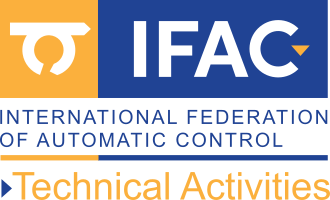Terminology in the Area of Fault Management
published in R. Isermann and P. Ballé: Trends in the Application of Model-Based Fault Detection and Diagnosis of Technical Processes. Control Engineering Practice, 5 (5), pp. 709-719, 1997. These definitions can also be found in R. Isermann: Fault Diagnosis Systems. Springer Verlag, Berlin, 2006, including corresponding literature. Some basic definitions can also be found in the literature cited under the section references and in the Germen standards like DIN and VDI/VDE-Richtlinien, which are also cited below.
1. States and Signals
- Fault: An unpermitted deviation of at least one characteristic property or parameter of the system form the acceptable / usual / standard condition.
- Failure: A permanent interruption of a system's ability to perform a required function under specified operating conditions.
- Mailfunction: An intermittant irregularity in the fulfilment of a system's desired function
- Error: A deviation between a measured or computed value (of an output variable) and the true, specified or theoretically correct value.
- Disturbance: An unknown (and uncontrolled) input acting on a system.
- Perturbation: An input acting on a system, which results in a temporary departure from the current state.
- Residual: A fault indicator, based on a deviation between measurements and model-equationbased computations.
- Symptom: A change of an observable quantity from normal behavior.
2. Functions
- Fault detection: Determination of the faults present in a system and the time of detection
- Fault isolation: Determination of the kind, location and time of detection of a fault. Follows fault detection.
- Fault identification: Determination of the size and time-variant behaviour of a fault. Follows fault isolation.
- Fault diagnosis: Determination og the kind, size, location and time of detection of a fault. Follows fault detection. Includes fault isolation and identification.
- Monitoring: A continuous real-time task of determining the conditions of a physical system, by recording information, recognising and indicating anomalies in the behaviour.
- Supervision: Monitoring a physical system and taking appropriate actions to maintain the operation in the case of faults.
- Protection: Means by which a potentially dangerous behaviour of the system is suppressed if possible, or means by which the consequences of a dangerous behaviour are avoided.
3. Models
- Quantitative model: Use of static and dynamic relations among system variables and parameters in order to describe a system's behaviour in quantitative mathematical terms.
- Qualitative model: Use of static and dynamic relations among system variables and parameters in order to describe a system's behavior in qualitative terms such as casualties or if-then rules.
- Diagnostic model: A set of static or dynamic relations which link specific input varables - the symptoms - to specific output variables - the faults.
- Analytic redundancy: Use of two or more (but not necessarily identical) ways to determine a variable, where one way uses mathematical process model in analytic form.
4. System Properties
- Reliability: Ability of a system to perform a required function under stated conditions, within a given scope, during a given period of time. Measure: MTBF = Mean Time Between Failures. MTBF=1/, lambda is rate of failure (e.g. failures per year).
- Safety: Ability of a system not to cause danger to persons or equipment or the environment.
- Availability: Probability that a system or equipment will operate satisfactorily and effectively at any point of time.
Measure: A=MTBF / (MTBF + MTTF)
MTFR: Mean Time To Repair
MTTR = 1/mu; mu: rate of repair - Dependability: A form of availability that has the property of always being available when required. It is the degree to which a system is operable and capable of performing its required function at any randomly chosen time during its specified operating time, provided that the item is available at the start of the period.
D= (Time available)(Time available + Time Required)
References on Terminology
- DIN 25424 Fehlerbaumanalyse (fault tree analysis). Beuth Verlag, Berlin, 1990.
- DIN 40041 Zuverlässigkeit in der Elektrotechnik (reliability in electrical engineering). Beuth Verlag, Berlin, 1990.
- DIN 31051 Instandhaltung (Maintanence). Beuth Verlag, Berlin, 1985.
- DIN 40042 Zuverlässigkeit elektrischer Geräte, Anlagen und Systeme (Reliability of electrical devices, plants and systems). Beuth Verlag, Berlin, 1989.
- DIN 55350 Begriffe der Qualitätssicherung und Statistik (Terms in quality control and statistics). Beuth Verlag, Berlin, 1989.
- IFIP working group 10.4. Reliable computing and fault tolerance, meeting in Como, Italy, 1983.
- Laprie, J.C. (1983). On computer system dependability and un-dependability: faults, errors, and failures. IFIP WG 10.4, Como, Italy, 1983.
- Lexikon Mess- und Automatisierungstechnik. (1992). VDI verlag, Düsseldorf.
- Reliability, Availability, and Maintainability Dictionary, ASQC Quality Press, Milwuakee, 1988.
- Robinson, A. (1982). A user-oriented perspective of fault-tolerant systems, models and terminologies. Proceedings of the 12th International Symposium on faulttolerant computing, Los Angeles
- VDI/VDE-Richtlinie 3541. Steuerungseinrichtungen mit vereinbarter gesicherter Funktion, Beuth Verlag, Berlin, 1985. VDI/VDE-Richtlinie 3541. Sicherheitstechnische Begriffe für Automatisierungssysteme. Beuth Verlag, Berlin, 1988.
- VDI/VDE-Richtlinie 3691. Erfassung von Zuverlässigkeitswerten bei Prozessrechnereinsätzen. Beuth Verlag, Berlin, 1985.

